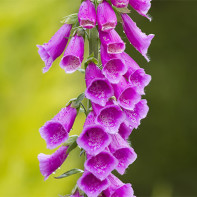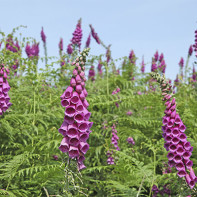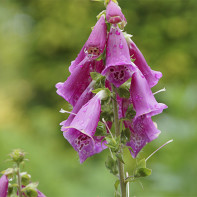Foxglove: medicinal properties and contraindications
In Latin, the name of digitalis purpureae sounds like "Digitalis purpureae". The first word in this case is translated as "finger", "thimble" or "ring", and the second describes the color of the flowers, that is, they are characterized by a mixture of purple and red hues. Because of this particular shape, the plant is popularly called the wood bell. Previously, when medicine was not so advanced, healers could not identify the full chemical composition of the crop and correctly determine the dosage, so patients often died during treatment with this herb. Based on this, foxglove is also called a witch's flower or witch's thimble.
- Chemical composition
- How it looks and where it grows
- Types
- Harvesting and storage
- How to grow foxglove
- Therapeutic properties of digitalis
- Foxglove in folk medicine
- Types of medicinal compositions
- Infusion
- Tincture
- Decoction
- Pharmaceutical preparations of digitalis
- Contraindications to use
- Foxglove poisoning
Beginning in the XVIII century this plant began to be used in medicine. It was during this period that the healing qualities of foxglove were revealed by official scientists. Specialists considered this crop to be one of the most effective therapeutic products of those times.

In the middle of the 19th century, the herb began to be used first by the Russian, then by the Soviet pharmaceutical industry. Several main species are known, which are most often used in the manufacture of preparations characterized by different therapeutic properties.
The leaves of the herb are the main parts that act as herbal raw materials. Usually they are collected in the first year of foxglove growth, when it reaches the right size. It is in this part of the plant that the maximum concentration of useful components is concentrated. To a greater extent, the useful characteristics of this flower are due to the presence in it of digoxin and lanagoside C. These components are effective in the fight against diseases of the cardiovascular system.
Ancient healers treated epilepsy, dropsy with the help of such a plant product. It is also known that the herb has long been used in informal medicine as an analgesic for dermatological pathologies of inflammatory nature. As for internal inflammations, bleeding, it was forbidden to use the flower.
Chemical Composition
To date, foxglove is quite well studied. It is noted that not all varieties have medicinal properties. In the leaves, flowers and stems of some species were found glycosides, saponins, flavonoids and other useful components.
Purple foxglove is an incredibly beautiful plant, which can be used for decorative purposes. But despite this, scientists have found more than six dozen glycosides in this variety that can treat heart disease. Among them there are primary glycosides A and B, which after drying and during storage are transformed into secondary glycosides. It is these that are used to produce the corresponding drugs.
The main drugs in this case are "digitoxin" and "higoxin". Both are indicated in the therapy of tachycardia and heart failure. The difference between them is that the first product is characterized by a high degree of cumulation, while the second drug has a lower level of toxicity, therefore, the cumulation here is also less.
The leaves of the herb also contain acetyl dihitoxin, which is used for tachycardia and arrhythmia caused by it. This substance is able to be absorbed quickly, but at the same time less accumulated in the body. In addition, a high concentration of saponins, choline and flavonoids is noted in the leaves of the plant.
What it looks like and where it grows
As noted above, there are many known varieties of forest bellflower, which grow in different parts of the world. These include Africa, Europe, Asia and the CIS countries. Digitalis is rare in the wild, so the plant is cultivated for medicinal use.
Digitalis is a biennial and perennial herb, depending on the variety. In the Mediterranean area it grows as a shrub, with a fairly tall stem, which reaches 150 cm. The leaves are very tumescent and dark green. They are clearly distinguished veins.
Externally, Digitalis purpurea differs in the first and second year of life. Initially, it forms root leaves, which are 20-25 cm long. As it grows, non-branched stems with leaflets develop. The flowers are quite large, the coloration is purplish-red. Flowering begins in summer and lasts until early fall.
Foxglove has almost the same description as its purple counterpart. The leaves of this variety have the same structure, colored in light green, the stems are pubescent. The culture begins to bloom in early July. The flowers of the herb have a yellowish tint.
Foxglove woolly has flowers that are colored whitish yellow on the outside and have lilac streaks on the inside.
Types
There are several known varieties of the plant, which differ from each other in the height of the stem, the color of the flowers, the structure of the corolla. In addition, each species differs in the shape and size of the leaves, the variant of veining and the degree of pubescence of the leaf plate.
- Digitalis yellow is most commonly found in central and southwestern Europe. This crop is a perennial herb that can be up to 1 m tall. It has smooth leaves and stems. It is characterized by rich yellow flowers, which was the reason for the appearance of this name. Yellow foxglove is widely used for decorative purposes. As for its use in informal medicine, there are almost no mentions of it.
- Purple foxglove is one of the most common and effective varieties of this plant. This variety has an erect, cylindrical stem. The herb is also characterized by beautiful, large purple-colored flowers. The height of this forest bell ranges from 1-1.2 m. Grows mainly in European regions and the Mediterranean. It is popular in traditional medicine and pharmacology. The leaves are used to produce medicinal preparations in the pharmaceutical industry.
- Decoctions and infusions obtained on the basis of such a product provide rapid healing of wounds and improve the condition of the patient with hysteria. Also purple foxglove is characterized by the presence of a number of mineral elements, acids of organic nature, flavonoids, various vitamins and other valuable compounds.
- The most unsightly representative of this family is the woolly foxglove. This species has smaller flowers compared to other varieties. In spite of this, the raw material is widely used in medicine. Because it contains acetyl dihitoxin and celanide, the ground parts of woolly digitalis are used to produce medicines that ensure normal functioning of the heart muscle. The greatest medicinal power is found in the leaves of this plant. In folk medicine, the raw material is used in the treatment of cardiac pathologies, as well as ascites.
- Large-flowered foxglove is presented as a perennial herbaceous plant not more than 1 m in height. It is characterized by a short root and straight stem. The leaves are light green in color and are about 20 cm long. This species is included in the list of the five most commonly used varieties in the medical field. A number of cardiac medicines are derived from this medicinal herb. It is often used to eliminate circulatory insufficiency. In the leaves of this medicinal herb are found many medicinal substances, including cardiac glycosides, minerals, tannins, saponins. To obtain raw material, it is recommended to collect the leaves between the end of August and the beginning of September.
- Foxglove perennial is a variety that is both a raw material for creating medicines and an ornamental plant. Perennials are characterized by a unique complex of beneficial substances for human health, which has allowed for several centuries to use them for therapeutic purposes. The herb is unpretentious in care, normally tolerates low temperatures and can grow with insufficient sunlight.
Gathering and storage
The medicinal plant material of foxglove are the leaves. In the first year of growth, the rosette leaves are used for this purpose, and they can be harvested up to three times during the summer period. In the second year, immediately after flowering, the stem leaves are harvested. It is important to start harvesting raw materials in this period, since violation of these terms leads to a decrease in the pharmacological properties of the herb. The leaves should be petiole-free, since they slow down the drying process and don't have any biologically active elements concentrated in them.
Raw material should be collected in dry, sunny weather, for it is in the light intensifies the intensity of the accumulation of glycosides. Remember that foxglove should be collected during flowering. If the plant is grown on two-year plantations and the grass of the first year is plucked, it is important to protect the root part of the culture from damage.
The therapeutic characteristics of foxglove can be reduced if the medicinal plant material is not stored properly. For this reason, you should pack the preparations well, so that the valuable components are preserved. The whole herb should be kept in a dry and light-protected place. Every year it is necessary to monitor the biological activity of the plant.
How to grow foxglove
It is easy to grow forest bellflower from seeds. Such a plant does not need daily cultivation, but along with this it gives good sprouts. In this case, you can perform even under-winter sowing of the culture, but it can also be done in late spring or early summer. You should first loosen the soil, mark out rows at a distance of 35-40 cm and then sow the seeds densely, but do not embed them deeply, you just need to add some sand. To retain moisture, it is recommended to put agrofoil on top.
After 10-14 days, seedlings appear, which should be carefully watered and protected from sunlight. At the same stage, thinning is done so that not less than 10 cm is left between the rosettes.
At the end of summer, the seedlings are transferred to a permanent place. In this case, seedlings should be planted at a distance of 25 cm from each other. In winter, the seedlings should be covered with dry leaves. Foxglove usually blooms in the second year of life.
This type of plant does not prefer excessive moisture and likes well-lit areas.
Therapeutic properties of digitalis
Preparations from elements of digitalis are characterized by antibacterial, diuretic, sedative, general tonic and immune-stimulating qualities.
- Remedies based on this plant provide normalization of the cardiovascular system, lower blood pressure, increase diuresis, eliminate edema, shortness of breath and lividity, stabilize blood circulation in tissues, and normalize tissue respiration. In addition, this product provides a strengthening of the body's defenses.
- Foxglove purple is used in the treatment of insomnia, headache, heart and CNS pathologies. Before using medicinal compositions with forest bellflower, it is necessary to study the instructions for use (even if the medicine was prescribed by a doctor). This is due to the fact that foxglove has a number of contraindications, which can cause serious health problems.
- In addition, preparations based on this culture are prescribed in the treatment of acute and chronic forms of heart failure, arrhythmia, congenital and acquired heart defects. Foxglove can help with hypertension, that is, it provides a lowering of blood pressure. The crop can also be used to treat ophthalmic diseases, namely to reduce eye pain in migraines and to lower intraocular pressure.
- Since digitalis has a diuretic and anti-edematous effect, it can be used to treat kidney disease. In this case, the plant will improve the excretion of fluid from the body. Lung pathologies can also be treated with digitalis, because it can reduce shortness of breath and improve the flow of oxygen to the cells.
- Due to the medicinal properties of digitalis, you can use it to treat flickering arrhythmias. For heart failure and epilepsy, medicines based on this herb are also often prescribed.
- The ointment based on the forest bell will help eliminate pain in dermatological inflammations. Diseases that have an infectious origin can also be treated with digitalis-based remedies.
Foxglove in folk medicine
Foxglove is characterized by a number of medicinal properties, which allows you to use it in the treatment of various diseases.
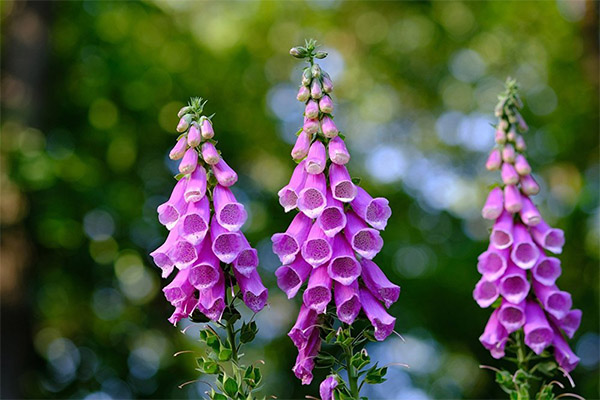
- So, with pathologies of the heart, you can prepare an infusion on the basis of dried raw materials, which should be crushed beforehand. In this case, it is necessary to measure about 1 g of leaves and pour them with a glass of water. Infusion should last for 10-12 hours. Ready solution to drink 2 times a day for 5 ml, regardless of meals.
- For the treatment of pathologies of the cardiovascular system, you can also use digitalis in powder form. Such a product does not affect the activity of the liver and kidneys. It is enough for an adult to take 0.1 g of powder twice a day. Such a remedy should be stored in a dark glass container, which is also hermetically sealed.
- You can prepare a decoction from the leaves of digitalis, which will help to normalize heart activity. To do this, 20 grams of dry raw materials pour 600 ml of boiling water and boil the composition until the volume of liquid in the pot is reduced by about 200 ml. Then cool the solution and pass through a filter. Medicinal composition to take 15 ml per day. If necessary, in the case of a severe course of the pathology, a specialist can change the dosage.
- Infusion of digitalis helps with hypertension. To prepare it, 1 g of dried leaves, pour 200 ml of boiled, slightly cooled water. Insist the remedy for 30-40 minutes. Ready to take the drug at 1 tbsp. several times a day. This composition is used for high blood pressure only with the permission of the attending physician.
- Digitalis can be used to treat cuts and burns because it has the ability to heal small wounds and injuries resulting from thermal burns. In such cases, you need to prepare a powder of dried raw materials, which is then sprinkled on the damaged surface. After treating the skin with this composition, use thin gauze bandages so that the dermis can breathe. You can also make lotions to heal wounds. This requires soaking a cloth in a decoction of the leaves and putting it on the damaged places for a quarter of an hour.
- In nervous diseases, the medicinal plant raw material is used to prepare a preparation. In this case, an alcoholic tincture is prepared. To do this, 20 g of raw materials should be placed in a dark glass container and pour a mug of wine alcohol. After that, cork the container, and then send it to a dark and warm place. Infusion should last for 7 days. It is important to shake the contents of the bottle periodically. A single dose should not exceed 30 drops of the obtained composition.
- Alcohol tincture is also used for nervous seizures. Prepare the medicine as follows. In a bottle made of dark glass, pour 20 grams of dried leaves, then pour them 50 ml of ethyl alcohol. Insist the mixture for a week in a dark place, shaking the container regularly. At the end of the specified time to filter the liquid. The resulting tincture to take 15 drops. At the same time, the specified amount should be diluted in 50 ml of boiled water.
- In the case of arrhythmia, an aqueous infusion of foxglove is prepared. To obtain the medicinal composition, take 1 g of dry, pre-milled raw materials and pour 180 ml of hot, boiled water. Then the mixture should stand under a lid for 60 minutes. After that, filter the liquid and take 3 times a day, 1 tsp. If the medicine is prepared for a child, for the same amount of water take twice as much herbal material. Children can take this infusion only after 12 years of age.
- If you grind dry leaves of foxglove in a coffee grinder, you get a powder that can be used for heart attacks. Need to take such a composition of the interior of 0.1 g no more than 4 times a day. Keep the finished powder in a dry, airtight container. The duration of treatment should not exceed 10-12 days.
Types of medicinal compositions
To prepare various healing compositions, you can use the powder obtained from the leaves of foxglove. To prepare it is very simple, you just need to cut the ground part of the herb, dry it for a few days under the sun, and then grind the dry mass to form a powdery consistency.
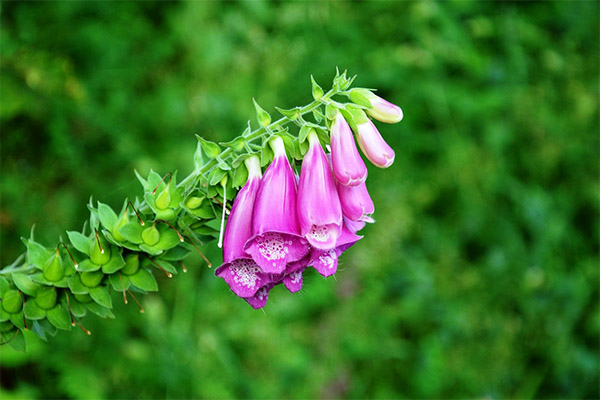
It should be remembered that in order to obtain high-quality medicinal raw materials, the plant should be collected away from the roads. The foxglove must be thoroughly washed before drying.
Infusion .
To prepare this composition, 3 g of dried herb should be poured over 250 ml of boiling water. Infuse the solution for 15 minutes. After that, filter the liquid. Add 1 drop of oil to the resulting amount of medicine. Take this composition of 1 tbsp. every 3 hours.
Tincture .
To obtain a tincture, you just need to pour 25 g of dried leaves of foxglove 60 ml of alcohol. Then the solution should insist for a week. The ready medication should be taken every day for 10 drops.
Decoction
Such a composition on the basis of digitalis helps to establish the activity of the heart. To prepare it, you need to pour 20 grams of herbal raw materials with three glasses of boiling water. The resulting mixture should be boiled until the volume of liquid is reduced by one glass. This decoction should cool, after which it must be filtered. Take a remedy of 2 tbsp. 1 time a day.
Pharmacy preparations with foxglove
Digitalis is characterized by a cardiotonic effect, which is due to the presence of cardiac glycosides in its composition. When administered internally, the drug begins to act after a period of time. These glycosides are slowly eliminated from the body, so they can accumulate in the body. This cumulative effect is more pronounced with digitoxin and less pronounced with digoxin.
Foxglove is used to treat heart failure, which is characterized by stagnation in the large and small circle of the circulation. Also drugs of this group are indicated for valve defects, myocardial dystrophy.
Therapeutic effect is expressed in the fact that the minute blood volume increases, blood pressure decreases, the amount of circulating blood decreases, blood flow accelerates, heart size decreases, diuresis increases and edema decreases.
During therapy it is important to monitor the CPS and the general condition of the patient. It is necessary to take into account that some patients may have individual hypersensitivity to certain components of the drugs. If side effects develop, treatment is suspended. Treatment with formulations based on digitalis is usually carried out by prescribing maximum doses in the first few days. This is done in order to achieve full therapeutic effect. Subsequently, maintenance doses are prescribed, which are determined by the level of excretion of the main active substances-glycosides. If the drugs are prescribed intravenously, the remedy is diluted with glucose solution beforehand.
Note that preparations based on foxglove should not be used for therapeutic purposes in bradycardia, atrioventricular blockade, frequent attacks of angina pectoris.
Leaves of the forest bellflower are used to produce a number of industrial drugs. In this case, the dosage form can be different. Foxglove is used to make tablets, tinctures, capsule preparations, injectable solutions.
The main preparations of purple foxglove are:
- "Digitoxin. Represents a tablet form of digitalis. This drug is intended for the treatment of heart failure, hypertension, heart valve defects, arrhythmia. It is characterized by a high degree of cumulation in the body and is rather poorly soluble.
- "Gitoxin. It has the same indications as the first drug. However, it differs in that it dissolves better and has a lower level of accumulation in the body. It is produced usually in the form of a powder of white color.
- "Cordigit. It is a combined drug that contains both of the above formulations. It is available in the form of tablets as well as rectal suppositories. It has a low cumulative effect and good solubility in water.
Contraindications for use
Despite the fact that foxglove is characterized by many useful qualities, there are still limitations in its use. Use remedies based on this medicinal plant is prohibited in the presence of high cholesterol in the coronary arteries, myocardial infarction, chronic lung diseases. Coronary heart disease, the period of carrying the baby and breastfeeding, infectious diseases, bradyarrhythmia and gastric tachycardia are also restrictions to the drugs of this group.

Foxglove can be dangerous for children's bodies, so it should not be given to children under 12 years of age.
In some cases, there is a hypersensitivity to the constituent substances of the herb.
Foxglove poisoning
Very often during the preparation of medicines based on the forest bell at home, people wonder whether intoxication can develop as a result of the use of such a plant product. Before using digitalis for therapeutic purposes, it is important to know that such a crop is characterized by toxicity, if the daily dose will be exceeded or in the process of preparing a healing composition, a larger amount of raw material was used.
Intoxication with such a plant is manifested by acute painful sensations in the abdomen, which are accompanied by diarrhea. Also in this case, a person will be nauseated, vomiting is frequent and quite painful. In addition, when poisoning with digitalis, a muffled pulse is observed, it seems that the heart is stopping.
Another side effect of exceeding the optimal doses is the appearance of rashes on the skin, which are similar to the usual irritation. In some cases, seizures occur along with uncontrollable muscle contractions. Hallucinations and memory lapses may occur.
It should be noted that several symptoms may occur simultaneously in digitalis intoxication.
It is important to keep in mind that in the most critical situations cardiac arrest occurs.
If even the most minor symptoms are detected, it is necessary to immediately call an ambulance team to get specialized help. You will not be able to solve the problem on your own.
Toxins that are concentrated in foxglove are able to accumulate in the body, resulting in the development of unpleasant consequences.
«Important: All information on this site is provided for informational purposes only purposes only. Consult a healthcare professional before applying any recommendations. specialist before you use any of the recommendations. Neither the editors nor the authors are liable for any possible harm caused by materials."

